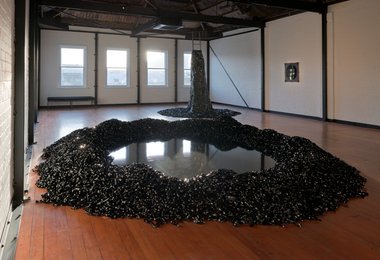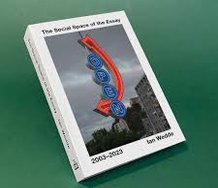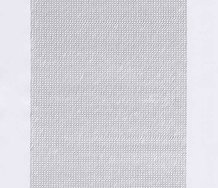Andrew Paul Wood – 12 September, 2012
It is an appropriate metaphor in an urban context where civic memory has become elusive. Many parts of Christchurch have become as “unreadable” and obsolete as VCR tape. At the same time, on purely formal grounds Flanagan's show is an amazing piece of contemporary art. It never once feels intentionally disposable, and is bold in its lack of obvious genealogical forebears.
Christchurch
Scott Flanagan
Do You Remember Me Like I Do?
1 September - 23 September, 2012
Scott Flanagan‘s Do You Remember Me Like I Do? at the Christchurch Art Gallery annex above NG is a tour de force. Followers of Flanagan’s career will be familiar with his use of VCR tape as a construction material and in this installation it is used to epic effect. The tape already has unrealised information magnetically coded within it, and here it is physically rearranged into yet another code, making it a metaphor for Wittgenstein’s paradox: the contingency of language and the impossibility for one person to ever perfectly understand the inscape of another - one of the many obsessions of this self-made artist.
Simply, but very effectively arranged on a small round table by the entrance are a collection of passport-sized artist books which Flanagan created from the pages of Readers Digest condensed volumes and then circulated among his friends in the art world. None are attributed, but if you are a dedicated art luvvie it is possible to work out at least some of them. Each little treasure has a picture of a rose from an old gardening catalogue which allows the collaborator to be identified from a master list in the artist’s possession. These will eventually be donated to Christchurch Art Gallery.
From there the viewer’s attention is rapidly swallowed up the two enormous installation components. The first of these is a wishing well - a large circular nest-like structure made from piled up VCR tape, with a bottom of the same material woven into a smooth, flat mat. The shiny black reflectiveness of the VCR tape does give something of the illusion of water, and like the Trevi Fountain in Rome punters do indeed throw money into it - perhaps a reference to the charitable money pit that post-quake Christchurch has become. The coins and notes add to the atmosphere of the piece - public interactive participation lends a particular aura of authenticity.
The second major component is a ladder, pointing in the direction of Flanagan’s old studio since demolished in the wake of the quake. There is a certain melancholic grandeur to it as it seems to be wearing a long black mourning gown of tangled VCR tape. The organic mass of this object is strikingly effective. Overall, one is reminded of some J.G. Ballard apocalyptic fantasy where the aesthetic pleasures of refuse and pollution have replaced nature:
Far from disfiguring the landscape, these discarded products of Twentieth-Century industry had a fierce and wayward beauty. Halloway was fascinated by the glimmering sheen of the metal-scummed canals, by the strange submarine melancholy of drowned cars looming up at him from abandoned lakes, by the brilliant colours of the garbage hills, by the glitter of a million cans embedded in a matrix of detergent packs and tinfoil, a kaleidoscope of everything they could wear, eat and drink. He was fascinated by the cobalt clouds that drifted below the surface of the water, free at last of all plants and fish, the soft chemical billows interacting as they seeped from the sodden soil. He explored the whorls of steel shavings, foliage culled from a metallic Christmas tree, the bales of rusting wire whose dense copper hues formed a burnished forest in the sunlight. He gazed raptly at the chalky whiteness of old china-clay tips, vivid as powdered ice, abandoned railyards with their moss-covered locomotives, the undimmed beauty of industrial wastes produced by skills and imaginations far richer than nature’s, more splendid than any Arcadian meadow. Unlike nature, here there was no death. - J.G. Ballard, “The Ultimate City” (1976)
It is an appropriate metaphor in an urban context where civic memory has become elusive. Many parts of Christchurch have become as “unreadable” and obsolete as VCR tape. Copious buildings are lost altogether, as if wiped by Error 404. At the same time, on purely formal grounds Flanagan’s show is an amazing piece of contemporary art. It never once feels intentionally disposable or self-consciously understated - a tedious problem with a lot of more recent art - and is bold in its originality and lack of obvious genealogical forebears. Visually sensual and unapologetically elegiac, it’s quite romantic and slow cooking.
Andrew Paul Wood




 Two Rooms presents a program of residencies and projects
Two Rooms presents a program of residencies and projects Advertising in this column
Advertising in this column



This Discussion has 0 comments.
Comment
Participate
Register to Participate.
Sign in
Sign in to an existing account.